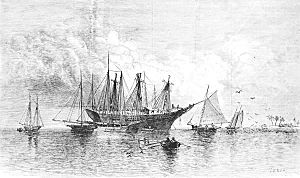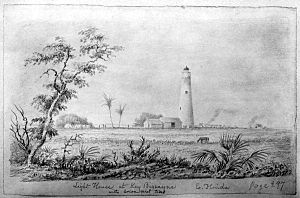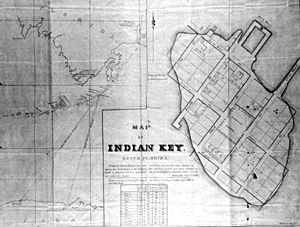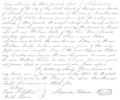William Cooley facts for kids
Quick facts for kids
William Cooley
|
|
|---|---|
| Born | 1783 State of Maryland
|
| Died | 1863 (aged 79–80) |
| Occupation | Justice of the Peace, politician, farmer, merchant, soldier |
| Known for | Florida pioneer |
| Political party | Democratic |
| Spouse(s) | Nancy Dayton (c. 1805–1836) |
| Children | Almonock Cooley (c. 1827–1836) Montezuma Cooley (c. 1835–1836) unnamed daughter (c. 1825–1836) |
| Signature | |
William Cooley (1783–1863) was an important early American settler and leader in what is now Broward County, Florida. His family was tragically killed by Seminoles in 1836 during the Second Seminole War. This event, known as the "New River Massacre," caused many white settlers to leave the area right away.
Cooley was born in Maryland in 1783. Not much is known about his early life before 1813. That year, he arrived in East Florida, which was then controlled by Spanish Florida, as part of a military group. He started as a farmer in the northern part of this area. Later, he moved south and traded with local Indians while continuing to farm.
When Florida was changing from Spanish to U.S. rule, Cooley supported the Native Americans in a land disagreement. A merchant had received a large land grant from the King of Spain and was forcing the Indians off their land. Cooley was unhappy with the Spanish actions. So, in 1826, he moved to the New River area to get away from Spanish influence.
At New River, Cooley made a living by salvaging goods from shipwrecks and farming. He grew and processed arrowroot, a plant used to make starch. His wealth and influence grew. He became the first law officer and judge in the settlement. He also worked as a land appraiser. However, local Indians blamed him for a decision they saw as unfair, involving the murder of one of their chiefs. In revenge, they attacked the settlement on January 4, 1836.
Cooley survived the attack and lived for another twenty-seven years. He held important jobs in Dade County. In 1837, he moved to Tampa. He also worked for a short time as a guide and messenger for the U.S. Army. In 1840, he moved to the Homosassa River area. There, he became the first postmaster and ran for a seat in the Florida House of Representatives for Hernando County. He returned to Tampa in 1847. He was one of the first city council members, serving three terms before he died in 1863.
Contents
Early Life and Moving to Florida
William Cooley was born in Maryland in 1783. We don't know much about his life before 1813. He was sometimes called William Cooley Jr., William Coolie, William Colee, or William Cooly.
Cooley arrived in East Florida in 1813. This was during a military campaign involving forces from Tennessee and Georgia. Some people believe Cooley fought with the Tennessee Volunteers. Others say he was a lieutenant in the Georgia Militia. Cooley bought land near the St. Marys River. This was close to where the military groups crossed East Florida that year. Later, he moved to the west bank of the St. Johns River. He settled about 30 miles (48 km) south of today's Jacksonville.
Cooley later moved to Alligator Pond, near what is now Lake City. There, he started a farm and traded with the local Seminole tribe. Their chief was named Micanopy. In 1821, East Florida officially became part of the United States. This happened because of a treaty signed in 1819. In 1820, a Spanish merchant named Don Fernando de la Maza Arredondo began settling a large area of land. This land, about 280,000-acre (1,130 km2) in the Alachua territory, was given to him by King Ferdinand VII of Spain. Cooley tried to help the Native Americans who were being forced off this land, but he was not successful. In 1823, Cooley moved away. He likely wanted to escape the Spanish influence. He moved to the north bank of the New River.
Life in New River
Like other settlers in New River, Cooley did not buy land. He simply lived on the land, hoping the United States government would survey it. He hoped they would then grant ownership to the people already living there. The settlement mostly had people from Bahamas. They made a living by hunting turtles, fishing, building ships, and salvaging goods from shipwrecks.
In 1830, Frankee Lewis, an early settler from the Bahamas, sold her businesses. Richard Fitzpatrick bought them. After Fitzpatrick arrived, the settlement grew. It had about 70 people. They started a plantation system, which used enslaved people.
Cooley's Business and Role
Cooley's main job was collecting, processing, and shipping Florida arrowroot. This was a starch made from the root of the coontie plant. Arrowroot was used to make bread dough, wafers, and biscuits. It was good for ships because it didn't spoil easily. The leftover pulp was used as fertilizer or animal feed. Many hundreds of Native Americans lived in the area because arrowroot was a main part of their diet.
The price for the starch was good, and Cooley's machinery worked well. He could produce about 450 lb (200 kg) per day. This brought Cooley a lot of success. His good fortune allowed him to spend time exploring the area, even as far north as Lake Okeechobee. He also gained more political influence. It is believed he married Nancy Dayton, a former Native American captive, on December 2, 1830.
In 1831, Richard Fitzpatrick, who owned a successful plantation, pushed for Cooley to become a Justice of the Peace. This made Cooley responsible for settling disagreements about people and property. He also punished minor offenders and watched over the activities of wreckers. Serious criminals were sent to jail in Key West. By this time, Cooley owned a schooner. He used it to take prisoners and to trade coontie, sugarcane, and tropical fruit with places like Cape Florida, Indian Key, Key West, and Havana.
While trade and farming were important, salvaging from shipwrecks was the most important economic activity. In 1832, newspapers in the north started saying that salvaging was just a way to hide piracy. The 33 percent fee that salvagers received made people suspicious. Cooley was already in charge of overseeing salvaging. He was also appointed by the territory to appraise (estimate the value of) sunken ships and their cargo. The number of hurricanes affected this activity. The very active 1835 hurricane season brought even bigger profits.
By 1835, Cooley had two sons and one daughter. His sons were named Almonock and Montezuma, after local Native American chiefs. His ten-year-old daughter and nine-year-old son were taught by Mary E. Rigby and Joseph Flinton.
Cooley was also appointed to appraise property and enslaved people for the Union Bank of Florida. His friend, Richard Fitzpatrick, bought Cooley's coontie and citrus plantation on the Miami River for $2,500. Fitzpatrick was later elected to represent Monroe County in the Territorial Legislative Council. The vote for Fitzpatrick in New River was unanimous, but the Key West Inquirer questioned it. Cooley's actions were also questioned, as he was the Justice of the Peace who conducted the voting.
Cooley's property in New River included a house that was "twenty feet by fifty feet [6 by 15 m], one story high, built of cypress logs." At least three enslaved people and several Native Americans grew sugar cane, corn, potatoes, pumpkins, and other vegetables on the twenty-acre (eight-hectare) property. It also had a pen with eighty hogs. Cooley's coontie watermill was twenty-seven by fourteen feet (eight by four meters). Cooley also owned property in Key West, which included a factory, storage houses, a kitchen, and quarters for enslaved people. He had coconut, lime, and orange trees, along with farm animals and wild fowl.
The New River Attack
Buildup to Conflict

Cooley had friendly relationships and traded with the Seminole Indians in the area. In the early 1800s, Creek Indians had moved from Alabama and joined the Seminoles. In 1835, white settlers killed Creek chief Alibama and burned his home during a dispute. As Justice of the Peace, Cooley jailed the settlers. However, they were released because there wasn't enough evidence after a hearing in Key West. The Creek people blamed Cooley, saying he held back evidence. This made the Creeks and white settlers more uneasy with each other. This led to the Creeks moving to the Okeechobee area.
Major Francis L. Dade, a military leader in Key West, heard rumors that Cuba and Spain were giving weapons to the Native Americans. Investigations did not prove this rumor. Reports from Fort Brooke, near today's Tampa, said that Native Americans there were refusing to move to Mississippi, even though the government said they had agreed to move peacefully. Dade, two companies of soldiers, and all available weapons were sent to Fort Brooke. This was the port where the Native Americans were supposed to start their journey. The Native Americans responded by gathering all their forces in the New River region. On December 28, 1835, Dade and 107 soldiers were ambushed while traveling from Tampa Bay to Fort King, near today's Ocala. Only three soldiers survived. The attackers lost only three men.
What Happened?
Six days later, Cooley led a large group to free the Gil Blas, a ship that had run aground the year before. This operation needed all the able-bodied men from the settlement. The next day, January 4, 1836, the Native Americans attacked the settlement.
Between fifteen and twenty Native Americans entered the Cooley house. They killed his family and the children's tutor. Two of Cooley's enslaved people disappeared.
The tutor's son came back to find his mother and two younger sisters. He managed to escape. He went south by boat to the Cape Florida Lighthouse. Along the way, he warned people at Arch Creek and the Miami River about the attack. This caused them to flee as well.
After the Attack
After the attack, the Native Americans burned the house. They left without attacking other homes. The next day, Cooley returned to bury the dead. It is not clear who told the salvaging team about the attack. After staying at the settlement for three days, Cooley went to the Cape Florida Lighthouse. One of the missing enslaved people appeared. He reported that he recognized the attackers as people the Cooley family knew. The enslaved person had heard the Native Americans say the attack was revenge because Cooley had failed to get the murderers of Chief Alibama convicted.
Cooley took charge of the camp at the lighthouse. Richard Fitzpatrick sent sixty enslaved people from his Miami plantation to the lighthouse. The settlers and enslaved people feared more attacks. They knew the lighthouse wasn't very safe. So, they boarded Cooley's schooner and smaller boats and escaped to Indian Key, 100 miles (161 km) north of Key West. Judge Marvin, a judge from Key West, accused Seminole (or Calusa, depending on the source) chief Chakaika of leading the attack on New River. This was not proven. However, it is known that Chakaika was an important leader who planned a major attack on Indian Key in 1840.
When Cooley arrived at Indian Key, he learned that Native Americans had tried to get weapons and ammunition. But the soldiers in the island's fort had stopped them. Meanwhile, more than two hundred people from nearby areas sought safety in the fort. Cannons were saved from the Gil Blas. The ship was later burned so the Native Americans couldn't take anything from it. Difficult sea conditions and fear of attacks scared the islanders. Cooley asked for forts to be built at New River and Cape Sable. But news soon came from the Miami River reporting that all white property had been destroyed. This stopped all new plans.
Cooley went back to New River. He found that the Native Americans had returned to loot the settlement. They had burned several other houses and plantations. In 1840, his request for money to cover his losses was denied by the United States House of Representatives. On January 16, 1836, he arrived in Key West on the steamboat Champion. He was appointed temporary lighthouse keeper and stayed until April of that year.
Cooley's Later Life and Politics
Cooley went back to salvaging goods from shipwrecks. Later that same year, he worked again as a Justice of the Peace. He also became an auctioneer, a job he was appointed to by the legislature.
Constant attacks and rumors made Floridian community leaders demand action. This forced the Navy to send Lieutenant Levin M. Powell to Key West. Lieutenant Powell built a small force of fifty seamen, ninety-five marines, and eight officers. This force was supported by two schooners and a U.S. Revenue Cutter called Washington. Powell asked Cooley to be his guide because Cooley knew a lot about Native American leaders and customs. Powell had some success, and by December 1836, the situation along the coasts was under control. Cooley went back to his usual duties in Indian Key, which was the county seat for Dade County. Not long after, he moved to Tampa but still worked as a guide sometimes.
General Thomas Jesup, who was based at Fort Dade, made Cooley an express rider in early 1837. Cooley's job was to deliver messages between Tampa Bay and Fort Heilman. This was a distance of 170 miles (270 km). That same year, reports spread that Cooley was sharing rumors about a Seminole chief leading a rebellion involving enslaved people and Native Americans. The general was worried Cooley might be directly involved, so he had him questioned. After this, a frustrated Cooley resigned from his position.
Becoming a Politician
Cooley became friends with Captain William Bunce, a store owner who wanted to keep Native Americans in the area. They were a source of cheap labor. Cooley became involved in local politics again. This time, he was against General Jesup, who wanted to remove all Native Americans from Florida. Judge Steele, a new person from Connecticut, was Cooley's friend in this fight.
By 1840, Cooley lived in Leon County with one enslaved person. He lived near the Homosassa River. The Armed Occupation Act of 1842 allowed people to get 160-acre (65 ha) land grants there. Because of his leadership, he not only got his own permit but also permits for 28 other settlers. He had a long exchange of letters with the General Land Office, which eventually ended well for him and the other settlers. In 1843, he ran for a seat in the Florida House of Representatives for the new Hernando County. However, he lost to James Gibbons. Two years later, he became the first postmaster in Homosassa and a County Commissioner of Fisheries. He sold his land grant to Senator David Levy Yulee between 1846 and 1847 and moved back to Tampa.
From 1848 to 1860, Cooley bought several properties in the Tampa area. This included one at Worth's Harbor. By 1850, he lived with seven enslaved people. He was a Captain of the "Silver Grays," a local defense group in Tampa in the 1850s. He owned a general store in the city, which he later sold to a member of the Tampa Masonic Lodge. In 1853, he was nominated as Port Warden of Tampa. By 1855, Cooley had become a leader in local politics. He was the chairman at a meeting of the Democratic Party in Tampa on August 4, 1855, with sixty-five members. He served as an alternate councilman for two months in the first Tampa council. He then served a full year term starting in February 1857. He returned in 1861 for another full term. Cooley estimated his personal wealth at $10,060 in 1860.
His Legacy
Cooley died in 1863 in Hillsborough County, Florida. His will was written in 1862 but was recorded after his death. It was filed by Francis Matthews, who said he was Cooley's son-in-law. In the document, Cooley's name is spelled William Cooly. Cooley left his property to friends, charities, a woman named Fanny Anne (listed as his daughter and wife of Francis Matthews), and three grandsons and four granddaughters. However, there is no proof that they were his blood relatives. Colee Hammock Park in Fort Lauderdale is located near where his old home in the New River Settlement used to be.
Images for kids
See also
 In Spanish: William Cooley para niños
In Spanish: William Cooley para niños









